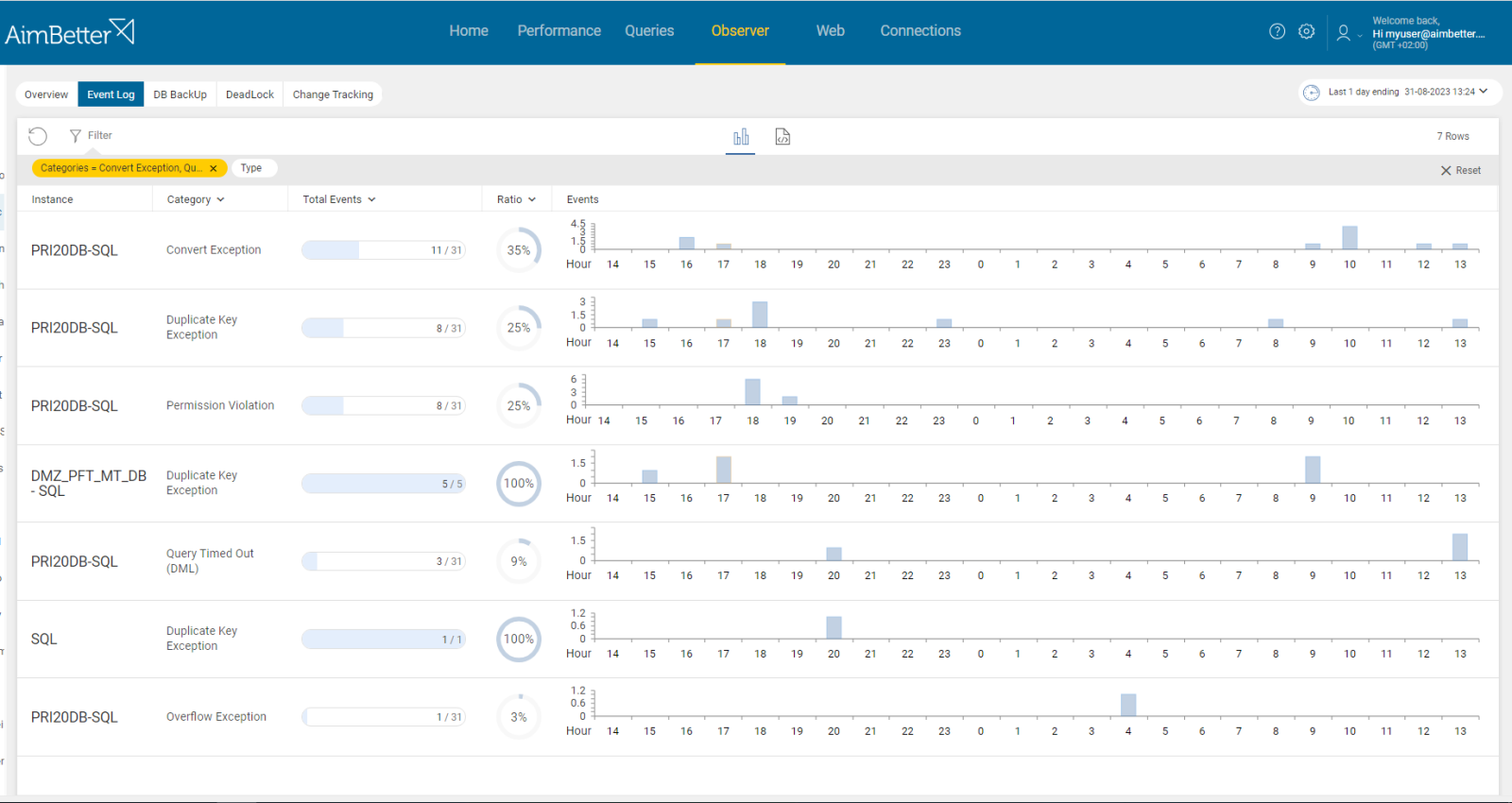SQL exceptions occur when a query has been executed but cannot be completed. The proper action required is to investigate the executing source code and correct any errors. Best practice requires that all SQL functions and calls be coded adequately with provision for possible failure via the TRY…CATCH protocol.
TRY CATCH protocol is an exception-handling technique used to catch and handle errors that might occur during the execution of SQL code.
There are various reasons why SQL Exceptions occur, including syntax errors, database issues, connectivity issues, and more. Each SQL Exception is provided with an error message describing the reason for failure and the error code. When an SQL exception occurs, it’s essential to investigate the relevant code segment and identify the cause of the error.
In cases where the exception involves a query, the Aimbetter platform provides details of the user name, application, hostname, client name, and process ID involved in the exception. It also enables complete tracking over time, ensuring high data control capabilities.
Find out how you can save hours of work when investigating the root cause of this issue.
Symptoms :
Incorrect coding may cause SQL errors during execution, impacting users who will receive error messages and be unable to complete operations. Consistent issues with SQL exceptions can damage a business’s flow, cause application downtime or errors, and disrupt normal business operations.
Impact: High
SQL Exceptions will interrupt user flow and potentially may cause a lack of functionality and influence application performance. This can negatively impact overall system value by degrading the performance and reliability of the data. Therefore, users’ experience will probably degrade as well.
Expected behavior :
SQL exception is an error that prevents the successful completion of a program, in which case the action that should result from this process is not done. Events like these are a disruption in the business flow and must be prevented.
Proper application design and programming should trap any possible failure of the coding to execute correctly. This is usually done by wrapping all SQL calls in a TRY… CATCH… THROW block, which tests whether the SQL statement can execute correctly and, if not, will perform the required action.
Exceptions reported by AimBetter:
Permission Violation: A user is trying to execute some function for which he/she does not have sufficient permission – e.g., reading data from a secure table. It can also occur when executing stored procedures if permission has not been granted to the user. The permission violation can be at the instance level, database level, schema, table, object, and more. The exception specifies the required permission, which is missing to complete the execution of the query.
Syntax exception: Occurs if the SQL Server cannot execute a command (INSERT or UPDATE or DELETE, etc). For example, if a table name is incorrect, the server would report “SQLServerException: Incorrect syntax near —.” Any syntax that violates the SQL languages will receive a syntax exception, for example, missing or incorrect keywords, quotation marks, joins, data types, or aliases.
Overflow exception: Arithmetic conversions between data types can result in an overflow (for example, converting data type Float into Integer if the result exceeds the upper limit).
Foreign key exception: A new key is inserted/updated in the parent table and does not also appear in another table that is designated as the child.
Convert exception: Conversion between different data types (string to a number, string to date) can fail. (For example, data from ‘DateTime’ is more restrictive and will throw an exception if the input does not precisely match the expected format.)
Duplicate key exception: SQL Server cannot insert a duplicate key in a table designated as having a unique index of the key field.
Table corrupted exception: SQL Server may report that a table in the database cannot be accessed because it has become corrupted. This may be due to various reasons, most typically hardware failure, but may also be because of an abrupt system shutdown when the database is open, changes in SQL account, or virus infection.
Null exception: reported if an INSERT or UPDATE command tries to add a NULL value into a table/column where the definition of the column does not allow a NULL value.
Parameter exception: The parameter count in a command (INSERT/UPDATE) does not match the values supplied. Our suggestion to avoid this possibility is to use Stored Procedures designed to pass parameters and handle the differing requests made.
Login exception: A user tries to log in with credentials that cannot be validated. This problem can occur if the login may be a SQL Server login, while the server only accepts Windows Authentication. Another possibility is that the user is trying to connect by using SQL Server Authentication, with a login that does not exist on SQL Server, or if the user’s password inserted is incorrect.
Query Timed Out (DML): a Data Manipulation Language (DML) query takes longer to execute than a specified maximum allowed duration, resulting in the query being automatically terminated and receiving a time-out.
Data Lost Suspect: Sometimes, when connecting to an SQL Server, you may find that the SQL database (DB) is marked as ‘SUSPECT.’ This may happen due to missing or corrupt transaction log files of the database, faulty hardware, virus attacks, or abrupt shutdown of the SQL server. This exception provides data about the suspected DB and, therefore, is not accessible.
Possible causes:
Errors during execution of the query. Priority: High
Without a proper error tracking system, you wouldn’t know if it happened only to you or multiple users and whether this issue is new.
Problem identification:
An error message is displayed during an operation related to SQL statements involving querying database instances.
- Get notified about this issue on your own or by other users because a sudden error message seems to be related to SQL operations.
- Use tracking tools such as SQL Server profiler or extended events to collect information about exceptions, and make sure to put appropriate filters to track the exact exception that needs to be investigated. This task must take time, won’t be provided with historical data, and should be done by a professional DBA.
- Examine the error messages and try to see if there are standard details such as host, database, and query involved to ensure you are tracking the same issue.
Aimbetter provides a complete insight into the database server. When exceptions exist, data is collected 24/7, and a monthly history is available.
Each exception involving an SQL query is attached with database, host, user name, client, and process ID, enabling convenient issues tracking.
You will get notified once an exception occurs many times. Use filters to focus the search and track any time range needed.
Recommended action :
Based on the error message, examine it and find out a solution. If possible, and not a query doing DML operations, retry it or change the code so it’s retriable without causing data changes.
Change the query code if needed according to the error message.
Break down complex queries into smaller parts and test them individually.
Check for violations and solve them.
Grant required permissions to users if needed and approved.
Regularly run DBCC CHECKDB to detect and repair corruption.
Last but important, ensure backups are implemented for disaster recovery cases!













